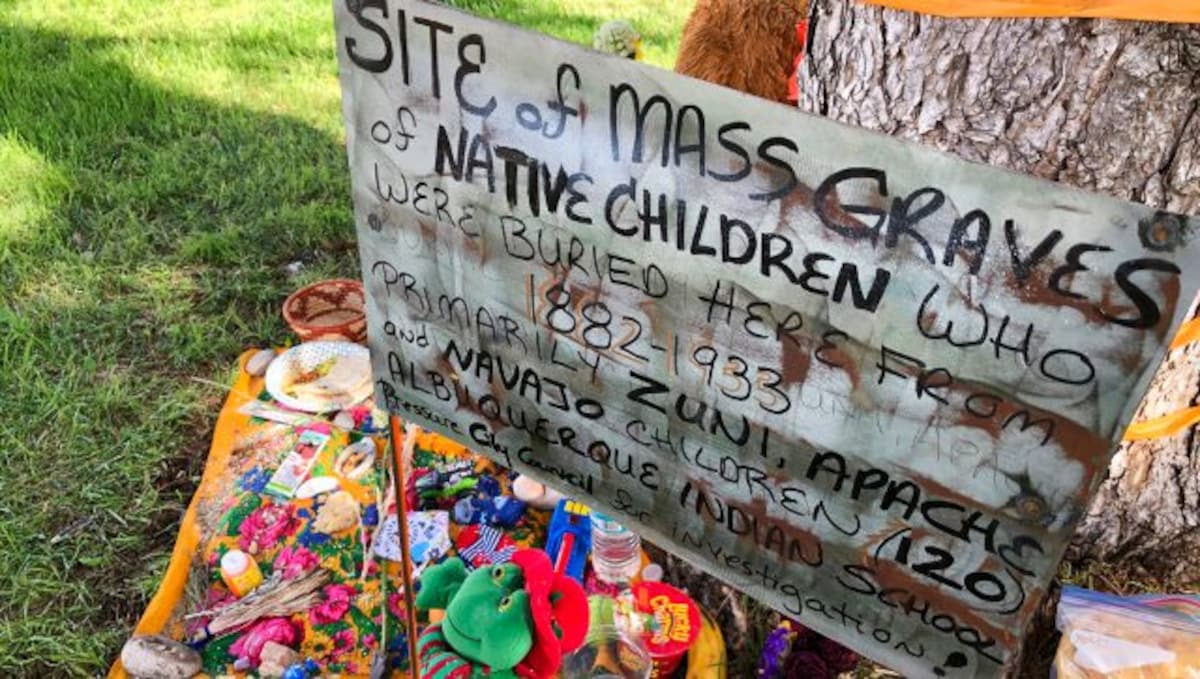
Interior Secretary Deb Haaland said on Wednesday that a federal probe into the grim history of Native American boarding schools discovered “marked or unmarked burial sites” at 53 of them.
Haaland, the first Native American cabinet member, announced the investigation last year. She spoke through tears and with a shaky voice during a press appearance in Washington, announcing preliminary findings.
“The federal policies that attempted to wipe out Native identity, language, and culture continue to manifest in the pain tribal communities face today,” Haaland said. “We must shed light on the unspoken traumas of the past.”
Until Wednesday, the US government had not provided any true accounting of the legacy of the schools, which used education to change the culture so tribal land could be taken.
Researchers found records on 408 schools that received federal funding from 1819 to 1969 and 89 schools that did not receive funding from the government. About half of the schools were run for the government by or supported by various churches. Activists and researchers claim that many children were abused in schools and tens of thousands went missing.
The report stated that “rampant physical, sexual, and emotional abuse” occurred at the schools. so far the investigation had found over 500 children who died while in school custody. Investigators said they expect to uncover many more deaths.
Road to healing
Haaland announced that she will embark on a year-long “road to healing” journey to hear from boarding school survivors. The investigation’s next objectives include estimating the number of children who attended the schools and locating more gravesites. Also, it includes determining how much federal money went to churches that participated in the school system, among other things.
She said that Congress had granted $7 million to keep the research going this year.
According to experts, the initial report on the probe only scratched the surface of what has to be investigated. The Interior Department has discovered more than 98 million pages of papers in the American Indian Records Repository. They may be related to the boarding school system that needs an evaluation. Hundreds of millions of pages from the National Archives and Records Administration’s regional branches must also go through an evaluation.
Haaland, a former New Mexico congresswoman, sponsored legislation in 2020 calling for a Truth and Healing Commission to investigate conditions at defunct Native American boarding schools. That bill is still in the works, with hearings on the most recent version slated for Thursday before a House of Representatives Subcommittee on Indigenous Peoples of the United States.
The report only scratches the surface of the trauma
The report only scratches the surface of the trauma, according to Deborah Parker, the head of the National Native American Boarding School Healing Coalition, which is supporting the Interior Department in its probe.
“Our children had names, Our children had families, Our children have their own languages,” she said at the press conference. “Our children had their own regalia, prayers, and religion before Indian boarding schools violently took them away.”
To create the report, researchers looked at official records and consulted with Native Americans. The findings reveal a history of education as a weapon that dates back to at least 1801 when the first such schools opened.
The War Department was in charge of Native American issues, including education, until 1849, and the military remained active even after civilians took over, according to the report.
The schools were similar to military academies in terms of regimentation and strictness, with a focus on vocational skills. The police forced the families to send their children to school. Families were denied food as another means of forcing them to give up their children.
“These conditions included militarized and identity alteration methodologies – on kids!” said Bryan Newland, the Interior Department’s assistant secretary for Indian Affairs, who is leading the probe.
Canadian Burial sites
Last year, when tribal leaders in Canada disclosed the discovery of the unmarked graves of 215 children at the site of the former Kamloops residential school for indigenous children, as such institutions are famous in Canada, conditions at former Indian boarding schools drew worldwide attention.
Unlike the United States, Canada conducted a comprehensive examination of its educational institutions through a Truth and Reconciliation Commission for the burial sites.
The US government has never recognized how many children attended such schools, how many died or went missing while attending them, or even how many schools existed.
The report was released on Wednesday. It included recommendations for supporting initiatives to preserve Native American languages, as well as the establishment of a federal memorial.
